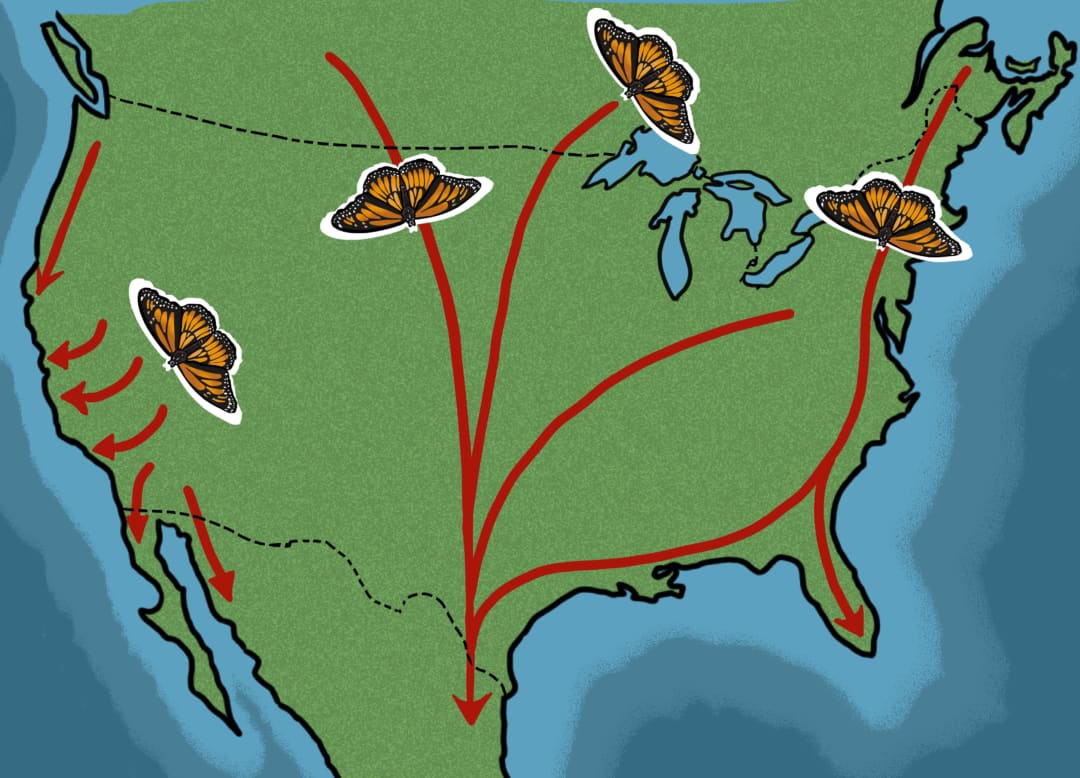As green turns to gold and leaves kiss the ground, millions of monarch butterflies across North America prepare for a treacherous journey to the south. Their iconic black and orange wings colour the Ontario sky from June to late September.
The threat of winter’s bitter winds drives these insects to seek refuge elsewhere, but none of them return north.
Where do they go, and why won’t they return?
These questions haunted Fred Urquhart, a professor of zoology at UTSC and a giant in monarch butterfly research. Following decades of research, the work of his wife Norah, and a generation of citizen scientists, Urquhart and his team discovered the wintering place of monarch butterflies in Mexico in 1975.
Late September to October: heading south
As he stood alongside volcanic mountains in the Mexican state of Michoacán, Urquhart was in awe of the sight before him.
“I gazed in amazement at the sight. Butterflies — millions upon millions of monarch butterflies! They clung in tightly packed masses to every branch and trunk of the tall, gray-green oyamel trees. They swirled through the air like autumn leaves and carpeted the ground in their flaming myriads on this Mexican mountainside,” Urquhart wrote in National Geographic, one year after the discovery.
Most monarch butterflies that live to the east of the Rocky Mountains overwinter in Mexico, while those to the west head to California. The monarchs that migrate to Mexico overwinter in the mountains of a region known as the Transverse Neovolcanic Belt.
The migratory route of these insects is triggered by three environmental cues: shortening days, cooling temperatures, and aging milkweed, the main food source for larvae. Although these events tell monarchs when to migrate, there is no clear consensus as to how they find the same 800 square kilometre sweet spot in central Mexico year after year.
A promising theory suggests that the butterflies use the time of day and the orientation of the sun to guide their flight path. Monarchs could further be assisted by southward warm air currents, which create a convection in combination with cold air currents, and propel them forward without energy wastage.
To prepare for their journey south, monarchs enter a delayed maturity phase, or diapause. Diapause ensures that the butterflies do not start mating, but instead ration their time and energy by drinking nectar.
Late November to March: wintering in Mexico
The Oyamel firs in Michoacán are critical for species survival and reproductive success. This fir species serves as both an umbrella and blanket — it creates a forest canopy that prevents heat loss during the night and shields the butterflies from rain. The canopy further creates a cool microclimate, which slows the butterflies’ metabolism and conserves their energy.
Breeding monarchs have a lifespan of one month and require nectar, which is not readily available at nearby sites, to fuel their reproduction. To survive, the monarchs must remain in diapause until winter months have ended in their North American habitat.
The next generation of monarchs is laid on milkweed plants in northern Mexico by the overwintering butterflies in early March. Having shorter lifespans, they do not undergo diapause and breed on their way back north.
Late March to July: heading north
Second generation monarchs are laid throughout eastern North America from late April to June. The larvae extract nutrients from milkweed, undergo metamorphosis, and emerge from late June to early July. This generation also does not undergo diapause, and therefore can mate and reproduce. The third and fourth generations will populate most of southern Canada, and migrate once again to Mexico according to environmental cues.
Conservation
Monarchs are increasingly threatened by climate change, habitat loss, and agricultural insecticides. Variations in temperature affect their breeding and migratory routes. Habitat fragmentation due to the loss of oyamel fir trees degrades the microclimate that is essential to their survival. The use of neonicotinoid insecticides delays development and has been linked to behavioural changes and even deaths. Parasites such as O. elektroscirrha expose monarchs to infection during their journey, reducing their flight endurance and lifespan. In addition, 20 million butterflies die in car accidents on their way to Mexico every year.
Conservation measures have been put in place to mitigate these losses.
In 1992, Orley “Chip” Taylor founded Monarch Watch, a citizen science project devoted to tagging and tracking monarch butterflies during migration.
The Monarch Butterfly Biosphere Reserve, designated a UNESCO World Heritage Centre in 2008, protects monarch butterflies’ overwintering sites that lie northwest of Mexico City.
Urquhart once said that the monarch butterflies “reveal the resilience of nature and the relentless drive of all life to endure. Such fragile wisps of life and beauty are elegant symbols of the plight of all living things in a world of ecological change.”
We should do what we can to protect them.
Editor’s note (28/10): This article has been updated to reflect more accurate information about the wintering patterns and conservation of monarch butterflies, and the foundations of Monarch Watch.


